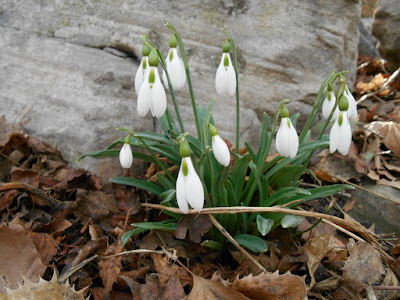Posted by Sarah Schweig, Broomfield County Extension
With the relentlessly hot weather lately, this post is devoted to gardening in that magical time that’s just around the corner - daytime temperatures are less severe, nights are cool, the soil has been warming all season, and (hopefully) we receive some rainfall. Early fall is a great time for establishing many plants, and a particularly pleasant time to be in the garden. At the top of my list are moving around some perennials, getting spring bulbs in the ground, and doing some much needed overseeding of the lawn. We’ve still got some time before these fall gardening tasks, but now is the time to prepare!
Planting Perennials
A window of opportunity for perennials opens once the hottest temperatures of the summer have subsided. If you stroll your favorite garden center around this time, the inventory may be low, but the prices usually are, too. It’s also a good time to divide and transplant many perennials. For overcrowded or overgrown plants, dividing every few years can support plant health. A general rule of thumb is not to divide plants when they are in bloom. For fall division, focus on plants that bloom from spring to early summer. Whether new plantings, transplants, or divisions, allow 4-6 weeks for plants to establish in their new homes before the ground freezes.
What to do now
Take some time to assess your spaces and plants while your garden is still in its full glory. Do you see overcrowding? Gaps in the landscape? These are your targets for division and transplanting. If (like me) you're just not feeling your original design anymore, that's also a good reason to change things up.
Fall-Planted Bulbs
What’s better than a gift you give your future self to open when you most need it? Enter crocus, squill, daffodils, and all the other hardy bulbs and corms that provide the first flush of spring color. On the Front Range, the ideal time to plant spring-blooming bulbs is late September into October. If planted after this window, roots may not have time to establish before the ground freezes, which is key to survival into the next season. If planted too early, the shoots may begin to develop this year. This takes valuable energy away from root establishment, which similarly reduces chances of success in the spring.
A window of opportunity for perennials opens once the hottest temperatures of the summer have subsided. If you stroll your favorite garden center around this time, the inventory may be low, but the prices usually are, too. It’s also a good time to divide and transplant many perennials. For overcrowded or overgrown plants, dividing every few years can support plant health. A general rule of thumb is not to divide plants when they are in bloom. For fall division, focus on plants that bloom from spring to early summer. Whether new plantings, transplants, or divisions, allow 4-6 weeks for plants to establish in their new homes before the ground freezes.
What to do now
Take some time to assess your spaces and plants while your garden is still in its full glory. Do you see overcrowding? Gaps in the landscape? These are your targets for division and transplanting. If (like me) you're just not feeling your original design anymore, that's also a good reason to change things up.
Fall-Planted Bulbs
What’s better than a gift you give your future self to open when you most need it? Enter crocus, squill, daffodils, and all the other hardy bulbs and corms that provide the first flush of spring color. On the Front Range, the ideal time to plant spring-blooming bulbs is late September into October. If planted after this window, roots may not have time to establish before the ground freezes, which is key to survival into the next season. If planted too early, the shoots may begin to develop this year. This takes valuable energy away from root establishment, which similarly reduces chances of success in the spring.
Shop! For the reasons above, it’s important not to be hasty with planting, but you’ll find many bulbs have been bought up by the ideal planting time. If you buy bulbs before it’s time to plant, store them in a dry location out of direct sunlight with good air circulation (net bags work well for this).
Seeding Cool Season Grasses
Whether you’re overseeding a few bare spots or planning an overhaul, you can seed cool season grasses like fescue, bluegrass, and ryegrass into the fall. Cool season grasses can even be seeded now, though higher temperatures mean even more diligence (and water) will be needed to maintain the moist conditions needed for seed germination and seedling survival.
Whether you’re overseeding a few bare spots or planning an overhaul, you can seed cool season grasses like fescue, bluegrass, and ryegrass into the fall. Cool season grasses can even be seeded now, though higher temperatures mean even more diligence (and water) will be needed to maintain the moist conditions needed for seed germination and seedling survival.
What to do now
Remember you’ll need to complete some pre-planting steps like choosing your seed, killing existing vegetation if needed, raking away debris, and aerating to prepare the seed beds.
Set yourself up for success by first asking why new grass is needed. Is the current grass species appropriate for your site and needs? Are irrigation issues contributing? Make adjustments now to avoid repeating the process next year.



No comments:
Post a Comment